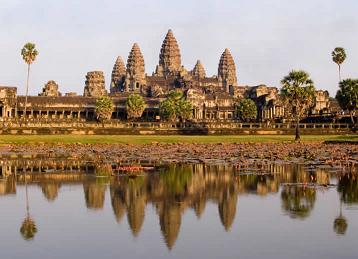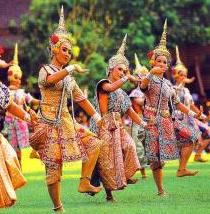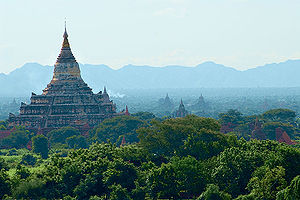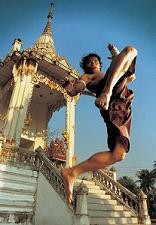|
|
|
|
 |
The
sheer diversity of cultures
in Southeast Asia has played a large part in the evolution of martial arts
in the region.Southeast Asia consists of contemporary Burma,
Cambodia, Indonesia, Laos, Malaysia, Thailand, and Vietnam. These countries
occupy both peninsular and island landforms, with China to the north and
India to the west.
Many of the distinctive cultural institutions, including the martial
systems, were shaped by Indian and Chinese civilizations.
At the same time, a wealth of religious practices - including
Shaminism,Christianity,Islam,Sikhism,Hinduism and Buddhism have all
cotributed to the philosophical underpinnings of indigenous,imported, and
hybrid art forms. |
|
EARLY
CULTURES
Although information regarding the earliest cultures in the area is sketchy
at best, archaeological evidence indicates that the area was populated
gradually and undramatically. Early immigrants of Malayan stock formed the
core of the indigenous population. The earliest cultures owe a debt to
southwestern China, and the religions were animistic. Much later with the
arrival of Hinduism and Buddhism (Mahayana, followed a few centuries later
by Hinayana) from India and, beginning in the thirteenth century, Islam,
many of these indigenous practices were absorbed into the imported
religions. Animistic principles may still be seen in Southeast Asian martial
systems.
The earliest history of the region (from Chinese sources) notes an Indian
presence in Annam (coastal "Indochina"), Cambodia, and Thailand and on the
islands of Java, Sumatra, and Celebes by at least the third century A.D.
Although influence came in from various regions of India, Indian cultural
features were restricted to the elite members of society, exerting no more
than minimal influence on the culture of the folk until the popularization
of Hinayana Buddhism in the thirteenth century.
The intrusion of European colonialism into the region had minimal impact on
traditional combative systems, beyond driving them underground in some
cases. In the period following Japanese incursions in World War 11, some
practitioners incorporated that nation's martial arts like karate into
native martial systems. |
DANCE AND DRAMA
The martial arts in Southeast Asia coexist with dance and drama
in some cultural traditions. Indonesia, Burma, and Thailand, for example,
maintained at least into the late twentieth century dances that incorporate
forms also seen in their combative arts. Among the Shan tribes of Myanmar in
the early twentieth century, dance embodied and was likely to have been a
vehicle for the practice of the indigenous boxing and weapons systems, and
traditionally both Muay Thai (Thailand) and
Lethwei (Burma) boxing matches
were preceded by martial dancing.
Pencak Silat (Indonesia) and
Bersilat (Malaysia) utilize musical
accompaniment during practice and exhibition. The role of silek (silat) as
an element of west Sumatran folk drama as recently as 1998 has been well
documented. |
 |
|
 |
Archaeological evidence in the form of
physical representations of human combat from the Khmer Empire (A.D.
802‑1431) that have been found in the thousands in association with the
Temple of Angkor Wat, built in the first
half of the twelfth century by Suryavarman 11 (r. 1113‑1150), and the walled
city of Angkor Thom and its Bayon Temple, built late in the same century by
jayavarman VII (1181‑1219), suggests a long history of martial arts.
Although contact from India came early on in Khmer history and exerted
profound cultural and religious influence, the statues and relief figures
portrayed more closely resemble Chinese boxing stances than any known arts
of India. |
Southeast Asian arts range from full-contact
aggression to a more gentle focus on self-development.
Muay Thai the direct
and effective kickboxing sport uses elbows and knees, is a simple yet brutal
art.
In contrast the Burmese art of
Pongyi-Thaing is non-violent and stresses Hindu and
Buddhist principles in an attempt to develop a practitioner's mind,body and
spirit.
Those who practice the ancient Burmese art of
Bando Yoga seek to cultivate
health and in former times their readiness for battle by defending
themselves against both armed attack from without and internal disease from
within, leading to a more peacefull existence free from confrontation and
conflict. |
 |
|
 |
Muay Thai
is the most widely recognized of the martial arts of Thailand. In its
contemporary form Muay Thai, or Thai boxing, is known as an international
sport. Precise information is lacking on the system's origins because of the
destruction of Siamese records in 1767 during one of their continuing
conflicts with Burma (now Myanmar). As a combative system, however, it has
figured prominently in the legends surrounding the centuries of conflict
between the two countries.
In the late eighteenth century, a tradition maintains that Thai boxer Nai
Khanom Tom was given the opportunity to fight for his
freedom after being captured in a battle against the Burmese. He affected
his release by defeating a dozen Burmese boxers. Other versions of this
legend vary in their particulars, but in all versions, the Thai triumphs. In
documented contemporary encounters, on the other hand, Muay Thai experts
have fallen to the larger Burmese fighters. |
|
|













